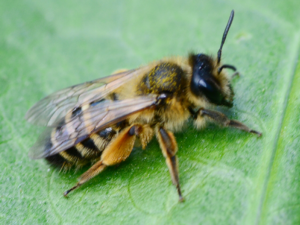Bee includes the laying of an egg, the improvement through a few sheds of a legless hatchling, a pupation stage during which the bug goes through a complete transformation, trailed by the development of a winged grown-up. Most lone bees and honey bees in mild environments overwinter as grown-ups or pupae and arise in spring while expanding quantities of blossoming plants start to sprout. The guys generally arise first and quest for females with which to mate. The sex of a still up in the air by whether the egg is treated; in the wake of mating, a female store the sperm, and figures out which sex is expected at the time every individual egg is laid, prepared eggs creating female posterity and unfertilized eggs, guys. Tropical bees might have a few pages in a year and rare zoological literature .
The egg is for the most part elongated, marginally bent and tightening toward one side. Lone bees lay each egg in a different cell with a stock of blended dust and nectar close to it. This might be moved into a pellet or set in a heap and is known as mass provisioning. Social bee species arrange continuously, that is to say, they feed the hatchling consistently while it develops. The home fluctuates from an opening in the ground or in wood, in single bees, to a significant design with wax brushes in bumblebees and bumble bees.
In many species

Hatchlings are whitish grubs, generally oval and gruffly pointed at the two finishes. They have 15 portions and spiracles in each fragment for relaxation. They have no legs except to move inside the cell, helped by tubercles on their sides. They have short horns on the head, jaws for biting food and a limb on one or the other side of the mouth tipped with a fiber. There is an organ under the mouth that secretes a thick fluid that sets into the silk they use to deliver a cover. The cover is hazy and the pupa should be visible through it. Throughout the span of a couple of days, the hatchling goes through a transformation into a winged grown-up. At the point when prepared to arise, the grown-up divides its skin dorsally and moves out of the exuviae and breaks out of the cell.
Bees have the accompanying qualities:
- A couple of enormous compound eyes cover a significant part of the outer layer of the head. Between or more these are three little basic eyes (ocelli) that give data on light power.
- The receiving wires typically have 13 fragments in guys and 12 in females, and are geniculate, having an elbow joint part way along. They house huge quantities of receptors that can distinguish contact (mechanoreceptors), smell and taste; and little, hairlike mechanoreceptors that can identify air development to “hear” sounds.
- The chest has three portions, each with a couple of vigorous legs, and a couple of membranous wings on the rear two sections. The front legs of corbiculate bees bear looks over for cleaning the radio wires, and in numerous species the rear legs bear dust crates, smoothed areas with incurving hairs to get the gathered dust.
- The wings are synchronized in flight, and the fairly more modest rear wings associate with the forewings by a column of snares along their edge which are associated with a score in the forewing.

